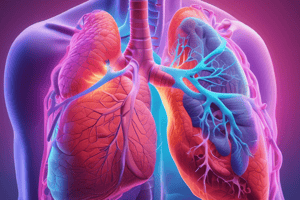Podcast
Questions and Answers
What is the volume of air moving in and out with each normal, quiet breath?
What is the volume of air moving in and out with each normal, quiet breath?
- 1 liter
- 1.2 liters
- 3 liters
- 500 ml (correct)
Which lung volume represents the amount of air inhaled or exhaled during a single breath?
Which lung volume represents the amount of air inhaled or exhaled during a single breath?
- Tidal volume (correct)
- Inspiratory reserve volume
- Expiratory reserve volume
- Residual volume
What is the volume of air that can be maximally exhaled below the tidal volume?
What is the volume of air that can be maximally exhaled below the tidal volume?
- 1 liter
- 0.5 liters
- 1.2 liters (correct)
- 3 liters
Which lung volume refers to the additional air that can be inhaled after a tidal volume has been breathed in?
Which lung volume refers to the additional air that can be inhaled after a tidal volume has been breathed in?
What is the volume of air that remains in the lungs after exhaling all possible air?
What is the volume of air that remains in the lungs after exhaling all possible air?
During a specific situation like going for a dive, which lung volume might be needed?
During a specific situation like going for a dive, which lung volume might be needed?
After exhaling the tidal volume, which lung volume represents the additional air that can be exhaled?
After exhaling the tidal volume, which lung volume represents the additional air that can be exhaled?
'Lung volumes refer to the volume of air in the lungs, measured at various phases of the respiratory cycle'. Which lung volume is not mentioned in this description?
'Lung volumes refer to the volume of air in the lungs, measured at various phases of the respiratory cycle'. Which lung volume is not mentioned in this description?
What is the additional air that can be exhaled after a tidal volume has been exhaled called?
What is the additional air that can be exhaled after a tidal volume has been exhaled called?
What might you need to use in a specific situation like going for a dive in the ocean?
What might you need to use in a specific situation like going for a dive in the ocean?
What is the primary reason for the 25-year-old man's visit to the pulmonologist?
What is the primary reason for the 25-year-old man's visit to the pulmonologist?
Which lung function test was ordered for this patient?
Which lung function test was ordered for this patient?
What is the patient's usual action after 10 minutes of intense workout?
What is the patient's usual action after 10 minutes of intense workout?
What is the main job of the lungs?
What is the main job of the lungs?
During an inhale, what happens to the diaphragm?
During an inhale, what happens to the diaphragm?
What instrument can be used to measure the volume of air moving in and out of the lungs?
What instrument can be used to measure the volume of air moving in and out of the lungs?
What type of test involves having an air chamber submerged in water that the person breathes into?
What type of test involves having an air chamber submerged in water that the person breathes into?
What happens to the chest muscles during an inhale?
What happens to the chest muscles during an inhale?
What is measured with a spirometer during a breathing test?
What is measured with a spirometer during a breathing test?
What does a classic spirometer use to trace a person's breathing pattern?
What does a classic spirometer use to trace a person's breathing pattern?
Flashcards are hidden until you start studying
Study Notes
Pulmonary Function Test
- A 25-year-old man is seen by a pulmonologist for exercise-related shortness of breath, which occurs after 10 minutes of intense workout and requires a 40-second break to catch his breath.
Lung Function and Spirometry
- The main job of the lungs is gas exchange, pulling oxygen into the body and getting rid of carbon dioxide.
- During an inhale, the diaphragm contracts and chest muscles contract to pull in air; during an exhale, the muscles relax, allowing the lungs to spring back to their normal size.
- A spirometer is used to measure the volume of air that moves in and out of the lungs with each breath, a test called spirometry.
Spirometry Results
- The plot of a healthy adult's spirometry results shows volume of air on the vertical axis and time on the horizontal axis.
- The tidal volume, typically around 0.5 L or 500 ml, is the volume of air moving in and out with each breath during normal, quiet breathing.
- The inspiratory reserve volume, typically around 3 liters, is the volume of air that can be maximally inhaled above the tidal volume.
- The expiratory reserve volume, typically around 1.2 liters, is the volume of air that can be maximally exhaled below the tidal volume.
- The residual volume, typically around 1.2 liters, is the amount of air that remains in the lungs after attempting to exhale all the air.
Lung Volumes
- Major lung volumes include the tidal volume, inspiratory reserve volume, expiratory reserve volume, and the residual volume.
- The functional residual capacity can be determined from a pulmonary function test.
Studying That Suits You
Use AI to generate personalized quizzes and flashcards to suit your learning preferences.




